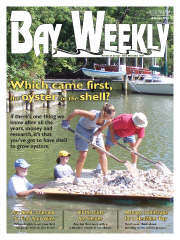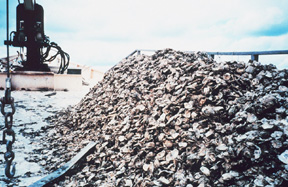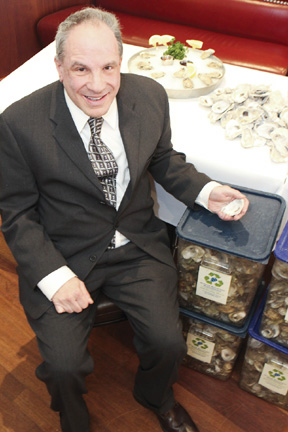Chesapeake Bay's Independent Newspaper ~ Since 1993
1629 Forest Drive, Annapolis, MD 21403 ~ 410-626-9888
Volume xviii, Issue 17 ~ Apri 29 to May 5, 2010
Home \\ Correspondence \\ from the Editor \\ Submit a Letter \\ Classifieds \\ Contact Us
Best of the Bay \\ Dining Guide \\ Home & Garden Guide \\ Archives \\ Distribution \\ Advertising![]()


Which Came First: The Oyster or the Shell?We Asked the Shell Savers
|
|
Just how much money, the enterprising Baltimore regional developer and environmentalist would rather not say. But a gift of $10,000, according to the Oyster Recovery Partnership, pushed its Shell Recycling Alliance into full production, returning to the Bay the hundreds of thousands of shells shucked in greater Chesapeake Country.
Inspired by shuckers who couldn’t bear the waste of perfectly good shell, the Alliance enlists big shell producers — even you and me, though we won’t get courtesy pick-up — in saving the Chesapeake by saving oyster shell.
The Partnership supplies five-gallon lidded plastic baskets and weekly pick-ups that raise a mountain of shell at the Horn Point Laboratory, where all this shell will eventually be seeded with new generations of oysters and planted in Bay sanctuaries.
Sixty thousand bushels of shell were “processed, cleaned and transported,” last year, according to Oyster Recovery Partnership executive director Stephan Abel. “They were, in turn, used to plant more than 650 million baby oysters back to the Bay.”
This year, with Legum’s seed money, the sky’s the limit.
Restaurants, seafood houses, caterers and hotels are being recruited to save every shell they shuck. A couple dozen have signed on so far, most in Baltimore and Annapolis, with one each in Washington, D.C., and Grasonville. The Annapolis shell savers are Boatyard Bar & Grill, Federal House, McGarvey’s Saloon, Middleton Tavern, Rams Head Tavern and Stan and Joe’s.
“I’m no Bill Gates,” Legum says. “You make a decision about what’s important to you. The Bay is more important to me than whether I have a top-line car or vacation home.”
Legum, who makes his home in Potomac, has been a champion of Bay causes over the years. Environmentally, he’s a 12-year board member of Friends of the Earth and supports the Society of Environmental Journalists’ annual Rachel Carson Environmental Book Award.
In this case, Legum put his money on shell, but he did so for the sake of Bay oysters. “Shell,” he said, “is what oysters live on.”
In oysters, shell and the Bay, Legum is highly invested, in both heart and mind. As a child, he spent his summers at his grandfather’s house on the Severn River. As a man, he allied with the oyster in support of the Bay. His appreciation for the bivalve is selfless. He doesn’t eat oysters; he works to preserve them for the good they do for the Bay.
Legum’s interest crystallized early in the decade when hope for our native oyster was dimmest.
“I was aggravated,” he told Bay Weekly, “when [then-Gov.] Ehrlich said our native oyster was toast. I didn’t believe for a minute that we couldn’t save them. Native oysters have come back in many areas, particularly when you build beds above the silt.”
Of imported Ariakensis oysters, the solution toward which Ehrlich was leaning, Legum said: “Ariakensis is perfectly nice to have a beer with, but not a good solution to Bay restoration.”
Gov. Martin O’Malley agreed. In O’Malley’s administration, Legum was appointed to Maryland’s Oyster Advisory Commission, helping write the recommendations that are now Maryland’s Oyster Restoration Plan.
“We were obligated to balance the interests of all the stake holders,” Legum says of the Commission’s recommendations. “If we were only looking at the health of the oyster, we could have gone farther.”
Legum took a step farther on his own. This year, Maryland’s money problems could have gotten between the Commission’s recommendations and oyster recovery. When the state appeared to have no money to plant shell on bottom, Legum stepped up. “I’ll put up the money,” he said.
So when you eat an oyster, remember that your next oyster can come from your empty shell.
Join the Shell Recycling Alliance at www.oysterrecovery.org. Or call the Partnership’s Bryan Gomes: 410-990-4970.
Nothing But the Best
Shell comes first for Len Zusa, as well. The Southern Maryland Oyster Cultivation Society has just taken delivery of 3,000 bushels of green oyster shells, and Zusa, the Society’s president, couldn’t be happier.

Volunteers from the Southern Maryland Oyster Cultivation Society plant oyster spat. |
In late May or early June, at the beginning of the oyster spawning season, SMOCS’ oyster-believing members will soon be layering that nice, clean shell in a half-dozen Calvert County creeks to make cozy beds for a million new oysters. The oysters were raised — from spat set in one of Maryland’s two oyster hatcheries, Horn Point or Piney Point — by citizen oyster gardeners. SMOCS members raised a third of them. Now one year old, the oysters are about an inch long and ready as they’ll ever be to be pushed out into the world.
Members of the Southern Maryland Oyster Cultivation Society are nothing if not dedicated. They’re amateurs, but they’ve elevated oyster cultivation to a science. They want their oyster babies to have the best possible start in the world.
So they’ve surveyed to find the best creek bottoms of firm sand, gravel or shell. “We look for a firm bottom because soft, mucky bottoms cannot be stabilized enough to prevent shells and oysters from sinking into the muck,” Zusa says.
Next, they lay three to six inches of costly green oyster shells.
“These shells act like a blanket that more or less locks together,” Zusa says. “This expansion of high-quality habitat will not only permit the deposit of upwards of a million oysters raised by local residents but will also provide clean shell for the set of wild oyster spat.”
Maryland Department of Natural Resources uses dredged, and often fragmented, shell to rebuild oyster beds. That’s not good enough for the Society.
“Larger shell has an undeniable benefit in that the spaces between shells give a perfect place for anemones, barnacles, sea squirts and all these creatures to go,” Zusa says. “In the St. Mary’s River, a study showed that even bare oyster shell supported the growth of all these other organisms.”
So only green shell — the grade DNR reserves for hatcheries — was good enough for their beds.
Dominion’s Cove Point in Lusby, the liquefied natural gas terminal, paid the $10,250 bill as a community service.
As DNR’s Mike Naylor says, “Shell is valuable.”
Learn more at www.smocs.org.
© COPYRIGHT 2010 by New Bay Enterprises, Inc. All rights reserved.

 photo © 2010 Erika Nortemann
photo © 2010 Erika Nortemann